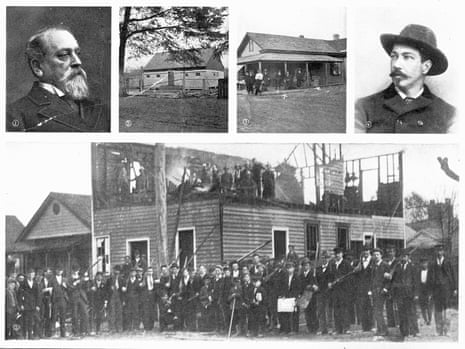In his new book, the Pulitzer prize-winning journalist David Zucchino illuminates a harrowing historical incident, the Wilmington coup of 1898, that is long forgotten by most. In doing so, he does a lot to explain our own interesting times. Racism among the poor in the service of maintaining elite power remains encouraged and rewarded.
This would seem to be the “special sauce” that links Nazi Germany, Brexit Britain and our own America, supposedly made “great again”. How else can so large a segment of Donald Trump’s base persist in defending all he does while his policies hit them hard? How can farmers agree with tariffs that cripple them? How can laid-off auto workers go along with a tax plan that offers them little relief?
Though the majority of welfare recipients are white, why is the caricature of a black woman loading a child-filled SUV with food stamp-obtained steaks and lobsters more visceral and despised than that of any recipient of corporate welfare? How do the 1% get away with scamming the system? Why is “legal” tax cheating, multibillion-dollar profits sheltered offshore, not condemned more?
As Lyndon Johnson warned, it is because the strongest fear among white Americans is not that blacks with little will gain too much. It is that whites will lose everything that is central to their identity.
White supremacy is about believing that the poorest, “worst”, least-educated white is superior to the “best” black. It matters not how talented, intelligent or scrupulously trained that African American might be. Trump will be counted a far greater president than Barack Obama. Melania Trump will be seen to be more beautiful and accomplished than Michelle.
In his riveting book, Zucchino retells one horrifying attempt to re-establish the “rightful place” of former slaves: starkly isolated, with scant hope of parity.
At the end of the 19th century, Wilmington, North Carolina, was a prosperous port. Today, fewer than 20% of its citizens are black. Then, it was narrowly majority black. White workers lived next to blacks and the black bourgeoisie was as proud and affluent as could be found anywhere in the US.
On 10 November 1898, by train and streetcar, a lynch mob arrived.
A black newspaper owner, Alexander L Manly, had written an editorial which dared debunk a cherished ideal, that of the inviolate purity of white women. Most black men charged with rape of white women, Manly wrote, had merely been discovered with willing lovers. But white men raped black women with impunity.
“Don’t think ever that your women will remain pure while you are debauching ours. You sow the seed – the harvest will come in due time.”
White papers knew just how to manipulate readers in return: to sound the clarion call, the old libel: that black men were out to take their jobs and women. Amid exhortations to restore decency and white government, white men stockpiled weapons.
Torching the Daily Record and banishing its impudent owner were a priority. But the mob of 2,000 did more, killing between 60 and 300 black people, injuring hundreds and driving 2,000, including “race traitors”, into permanent exile.
Forcing resignations at gunpoint, they overthrew a municipal government on which served two black aldermen and seven whites, elected by black and white workers alike.
This brutal coup was carried out by the mob. But it was fueled by an embittered, vengeful elite. To them, in 1861, seceding from the union had made perfect sense. Alone, the value of the Confederate states’ nearly 4 million slaves exceeded the amount invested in every bank, railroad and industry in the US combined. For more than a century, cotton was America’s leading export.
High hopes were dashed by defeat. Rebel leaders saw their property confiscated. But during Reconstruction, even under occupation by federal troops, even with white former combatants disenfranchised, the rights of blacks remained precarious. Once the troops withdrew, intimidation and terror, voter suppression and ballot stuffing, all arrived in earnest.
Confederates regained vote and property by so small an expedient as pledging loyalty to a victor they thoroughly loathed. By 1898, North Carolina’s unrepentant planter class had flipped the state legislature from a Republican-Populist alliance back to the Democrats of old.
In Wilmington, coup leader Col Alfred Waddell proclaimed a “White Declaration of Independence” and installed himself as mayor. And that was that. Locals came almost to believe the official version of events: it had been a “race riot”, started by blacks. Via poll taxes and grandfather clauses, seven decades of black disenfranchisement ensued.
But were such tactics less deliberate and systematic than the gentrification of today, so different from the gerrymandering and voter ID efforts of modern Republicans? Was the evisceration of the Voting Rights Act led by the supreme court chief justice, John Roberts, citing a “changed south”, distinct from the evacuation of federal soldiers so long ago?
Each action has left black self-governance further curtailed.
Michael Jordan, the pioneering architect Robert Taylor, tennis great Althea Gibson: all were raised in Wilmington. Zucchino’s book should make their seaside town known again for one of the darkest events in American history.
The author quotes a pamphlet produced in 1898 by a black Wilmington exile, the Rev J Allen Kirk. Titled A Statement of Facts Concerning the Bloody Riot in Wilmington, North Carolina of Interest to Every Citizen of the United States, it is worth quoting at length:
It was a great sight to see them marching from death, and colored men, colored women, colored children, colored enterprise and colored people all exposed to death. Firing began, and it seemed like a mighty battle in wartime. The shrieks and screams of children of mothers of wives were heard, such as cause the blood of the most inhuman person to creep. Thousands … rushed to the swamps, and lay upon the earth to freeze and starve. The woods were filled with colored people. The streets were dotted with their dead bodies …
